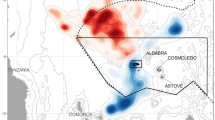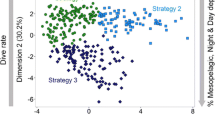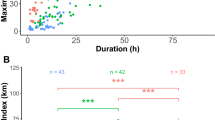Abstract
The ability of predators to switch between hunting and scavenging (facultative scavenging) carries both short-term survival and long-term fitness advantages. However, the mechanistic basis for facultative scavenging remains poorly understood. The co-occurrence of tiger sharks (Galeocerdo cuvier) and green turtles (Chelonia mydas) at Raine Island (Australia), provides an opportunity to examine a top marine predator’s feeding mode in response to seasonal pulses in nesting turtles that offer both hunting and scavenging opportunities. Using satellite telemetry, we evaluated home range overlap between sharks and turtles and quantified their surfacing behavior around Raine Island during the turtle nesting season. We found core home range overlap to be highest during the nesting season. Both sharks and turtles spent significantly more time at the surface in areas of greatest range overlap closest to shore, where turtle density was highest. Both sharks and turtles showed decreased surfacing with increasing distance from Raine Island. Combined with published data on turtle demography at Raine Island, we propose the following: (1) sharks patrol the surface to increase scavenging opportunities on turtle carcasses and intercept weakened individuals after nesting; (2) healthy turtles may not perceive sharks as a major threat and/or other biological factors override anti-predatory responses; and (3) sharks during the nesting season may primarily scavenge on dead turtles individuals rather than actively hunt. Our study results and approach may be applicable to other situations in which direct observations of predator-prey interactions are limited.
Significance Statement
Every animal encounters dead or dying resources, yet the role of facultative scavenging has been difficult to study, and thus largely overlooked in marine behavioral ecological research. Movement analyses of tiger shark and green turtle movement and surfacing behavior at Raine Island (Australia) suggest that facultative scavenging may be a prevalent, yet underappreciated, feeding strategy in tiger sharks. Our integration of behavioral ecology theory with multi-species electronic tagging provided a valuable approach for investigating predator-prey interactions in situations where direct observations are limited or not possible.




Similar content being viewed by others
References
Afonso AS, Hazin FHV (2015) Vertical movement patterns and ontogenetic niche expansion in tiger shark, Galeocerdo cuvier. PLoS One 10:e0116720. doi:10.1371/journal.pone.0116720
Beasley J, Olson CHZ, DeVault TL (2012) Carrion cycling in food webs: comparisons among terrestrial and marine ecosystems. Oikos 121:1021–1026
Bell IP, Seymour J, Fitzpatrick R, Hogarth J (2009) Inter-nesting dive and surface behavior of green turtles, Chelonia mydas at Raine Island, Northern Great Barrier Reef. Mar Turt Newsl 125:5–7
Bernard Y, Belbeoch M (2010) Improving Argos Doppler location with Kalman filtering – Advantages for Argos Floats. CLS ARGOS User’s Manual. Argos System, http://www.argos-system.org/files/pmedia/public/r283_9_new_argos_location_for_argo.pdf
Bonazzo A, Collin SP (2000) Retinal ganglion cell topography in Elasmobranchs. Brain Behav Evol 55:191–208
Burkholder DA, Heithaus MR, Fourqurean JW, Wirsing A, Dill LM (2013) Patterns of top down control in a seagrass ecosystem: could a roving apex predator (Galeocerdo cuvier) induce a behavior-mediated trophic cascade? J Anim Ecol 82:1192–1202
Carbonne C, Teacher A, Rowcliffe JM (2007) The costs of carnivory. PLoS Biol 5:e22
Clua E, Chauvet C, Read T, Werry JM, Lee SY (2013) Behavioral patterns of a tiger shark (Galeocerdo cuvier) feeding aggregation at a blue whale carcass in Prony Bay, New Caledonia. Mar Freshw Behav Physiol 46:1–20
DeVault TL, Rhodes OE, Shivik JA (2003) Scavenging by vertebrates: behavioral, ecological, and evolutionary perspectives on an important energy transfer pathway in terrestrial ecoystems. Oikos 102:225–234
Doyle TK, Bennison A, Jessopp M, Haberlin D, Harman LA (2015) A dawn peak in the occurrence of ‘knifing behavior’ in blue sharks. Anim Biotelem 3:46
Dudley SF, Anderson-Reade MD, Thompson GS, McMullen PB (2000) Concurrent scavenging off a whale carcass by great white sharks, Carcharodon carcharias, and tiger sharks, Galeocerdo cuvier. Fish Bull 98:646–649
Fallows C, Martin RA, Hammerschlag N (2012) Comparisons between white shark-pinniped interactions at Seal Island (South Africa) with other sites in California (United States). In: Domeier ML (ed) Global perspectives on the biology and life history of the great white shark. CRC Press, Boca Raton, FL, pp. 105–117
Fallows C, Gallagher AJ, Hammerschlag N (2013) White sharks (Carcharodon carcharias) scavenging on whales and its potential role in further shaping the ecology of an apex predator. PLoS One 8:e60797
Ferriera LC, Thums M, Meeuwig JJ, Vianna GMS, Stevens J, McAuley R, Meekan MG (2015) Crossing latitudes-long distance tracking of an apex predator. PLoS One 10:e0116916
Fitzpatrick R, Thums M, Bell I, Meekan MM, Stevens JD, Barnett A (2012) A comparison of seasonal movements of tiger sharks and green turtles provides insight into their predator-prey relationship. PLoS One 7:e51927
Fu AL, Hammerschlag N, Lauder GV, Wilga CD, Kuo CY, Irschick DJ (2016) Ontogeny of head and caudal fin shape of an apex marine predator: The tiger shark (Galeocerdo cuvier). J Morphol DOI:10.1002/jmor.20515
Gallagher AJ, Jackson T, Hammerschlag N (2011) Occurrence of tiger shark (Galeocerdo cuvier) scavenging on avian prey and its possible connection to large-scale bird die-offs in the Florida Keys. Fla Sci 74:264–269
Gallagher AJ, Wagner DN, Irschick DJ, Hammerschlag N (2014) Body condition predicts energy stores in apex predatory sharks. Conserv Physiol 2:cou022
Gallagher AJ, Hammerschlag N, Cooke SJ, Costa DP, Irschick DJ (2015) Evolutionary theory as a tool for predicting extinction risk. Trends Ecol Evol 30:61–65
Hammerschlag N, Martin RA, Fallows C (2006) Effects of environmental conditions on predator-prey interactions between white sharks (Carcharodon carcharias) and Cape fur seals (Arctocephalus pusillus pusillus) at Seal Island, South Africa. Environ Biol Fish 76:341–350
Hammerschlag N, Gallagher AJ, Lazarre DM (2011) A review of shark satellite tagging studies. J Exp Mar Biol Ecol 398:1–8
Hammerschlag N, Gallagher AJ, Wester J, Luo J, Ault JS (2012) Don’t bite the hand that feeds: assessing ecological impacts of provisioning ecotourism on an apex marine predator. Funct Ecol 26:567–576
Hammerschlag N, Broderick AC, Coker JW, et al. (2015) Evaluating the landscape of fear between apex predatory sharks and mobile sea turtles across a large dynamic seascape. Ecology 96:2117–2126
Hart N, Lisney T, Collin S (2006) Visual communication in elasmobranchs. In: Ladich F, Collin S, Moller P, Kapoor B (eds) Communication in fishes, 1st edn. Science Publishers, New Jersey, pp. 337–392
Hays GC, Akesson S, Broderick AC, Glen F, Godley BJ, Lushi P, Martin C, Metcalfe JD, Papi F (2001) The diving behavior of green turtles undertaking oceanic migrations to and from Ascension Island: dive durations, dive profiles, and depth distribution. J Exp Biol 204:4093–4098
Heithaus MR (2001) The biology of tiger sharks, Galeocerdo cuvier, in Shark Bay, Western Australia: sex ratio, size distribution, diet, and seasonal changes in catch rates. Environ Biol Fish 61:25–36
Heithaus MR, Frid A (2003) Optimal diving under the risk of predation. J Theor Biol 223:79–92
Heithaus MR, Frid A, Dill L (2002) Shark-inflicted injury frequencies, escape ability, and habitat use of green and loggerhead turtles. Mar Biol 140:229–236
Heithaus MR, Frid A, Wirsing AJ, Dill LM, Fourqurean JW, Burkholder D, Thomson J, Bejder L (2007) State-dependent risk taking by green sea turtles mediates top-down effects of tiger shark intimidation in a marine ecosystem. J Anim Ecol 76:837–844
Heithaus MR, Wirsing AJ, Thomson JA, Burkholder DA (2008) A review of lethal and non-lethal effects of predators on adult marine turtles. J Exp Mar Biol Ecol 356:43–51
Holmes BJ, Sumpton WD, Mayer DG, Tibbetts IR, Neil DT, Bennett MB (2012) Declining trends in annual catch rates of the tiger shark (Galeocerdo cuvier) in Queensland, Australia. Fish Res 129-130:38–45
Jackson JBC, Kirby MX, Berger WH, et al. (2001) Historical overfishing and the recent collapse of coastal ecosystems. Science 293:629–637
Jessop TJ (2001) Modulation of adrenocortical stress response in marine turtles (Cheloniidae): evidence for a hormonal tactic maximizing maternal reproductive investment. J Zool 254:57–65
Limpus CJ, Miller JD, Parmenter CJ, Limpus DJ (2003) The green turtle Chelonia mydas, populations of Raine Island the northern Great Barrier Reef: 1843–2001. Mem Queensl Mus 49:349–440
Lotze HK, Worm B (2009) Historical baselines for large marine animals. Trends Ecol Evol 24:254–262
Madsen T, Shine R (1996) Seasonal migration of predators and prey: a study of pythons and rats in tropical Australia. Ecology 71:149–156
Martin RA, Hammerschlag N, Collier R, Fallows C (2005) Predatory behavior of white sharks (Carcharodon carcharias) at Seal Island, South Africa. J Mar Biol Assoc UK 85:1121–1135
McShea WM (2000) The influence of acorn crops on annual variation in rodent and bird populations within oak dominated forests. Ecology 8:228–238
Meyer CG, Papastamatiou YP, Holland KN (2010) A multiple instrument approach to quantifying the movement patterns and habitat use of tiger (Galeocerdo cuvier) and Galapagos sharks (Carcharhinus galapagensis) at French Frigate Shoals, Hawaii. Mar Biol 157:1857–1868
Nakamura I, Watanabe YY, Papastamatiou YP, Sato K, Meyer CG (2011) Yo-yo vertical movements suggest a foraging strategy for tiger sharks Galeocerdo cuvier. Mar Ecol Prog Ser 424:237–246
Nakamura I, Goto Y, Sato K (2015) Ocean sunfish rewarm at the surface after deep excursions to forage for siphonophores. J Anim Ecol 84:590–603
Newton I (2008) The migration ecology of birds. Academic Press, London
Ostfeld RS, Keesing F (2000) Pulsed resources and community dynamics of consumers in terrestrial ecoystems. Trends Ecol Evol 15:232–237
Papastamatiou YP, Meyer CG, Carvalho F, Dale JJ, Hutchinson MR, Holland KM (2013) Telemetry and random-walk models reveal complex patterns of partial migration in a large marine predator. Ecology 94:2595–2606
Paquet PC (1992) Prey use strategies of sympatric wolves and coyotes in Riding Mountain National Park, Manitoba. J Mammal 73:337–343
Pereira LM, Owen-Smith N, Moleon M (2014) Facultative predation and scavenging by mammalian carnivores: seasonal, regional, and intra-guild comparisons. Mammal Rev 44:44–55
Simpfendorfer CA, Goodreid AB, McAuley RB (2001) Size, sex, and geographic variation in the diet of the tiger shark, Galeocerdo cuvier, from Western Australian waters. Environ Biol Fish 61:37–46
Sims DW, Witt MJ, Richardson AJ, Southall EJ, Metcalfe JD (2006) Encounter success of free-ranging marine predator movements across a dynamic prey landscape. Proc R Soc Lond B 273:1195–1201
Werry JM, Planes S, Berumen ML, Lee KA, Braun CD, Clua E (2014) Reef-fidelity and migration of tiger sharks, Galeocerdo cuvier, across the Coral Sea. PLoS One 9:e83249
Wilson EE, Wolkovich EM (2011) Scavenging: how carnivores and carrion structure communities. Trends Ecol Evol 26:129–135
Witt MJ, Akesoon S, Broderick AC, Coyne MS, Ellick J, Formia A, Hays GC, Luschi P, Stroud S, Godley BJ (2010) Assessing accuracy and utility of satellite-tracking data using Argos-linked Fastloc-GPS. Anim Behav 80:571–581
Witzell WN (1987) Selective predation on large cheloniid sea turtles by tiger sharks (Galeocerdo cuvier). Jpn J Herpetol 12:22–29
Acknowledgments
We thank J. Rumney from Eye to Eye Marine Encounters and the crew of Undersea Explorer for help with data acquisition. Thanks also to Emily Nelson, Julia Whidden, and Rachel Skubel for helping with formatting and proof editing the manuscript. Thanks to the editor and reviewers, whose comments helped significantly strengthen this paper.
Author information
Authors and Affiliations
Corresponding author
Ethics declarations
All applicable international, national, and/or institutional guidelines for the care and use of animals were followed. Research was approved and conducted under Australian Fisheries Management Authority Scientific Permit #901193 and Great Barrier Reef Marine Park Authority G11/33231.1. Funding was supplied by Digital Dimensions, Australia, through the production of documentaries related to shark research. The funders had no role in study design, data collection and analysis, decision to publish, or preparation of the manuscript. All authors confirm no conflict of interest or competing interests with respect to this study.
Additional information
Communicated by C. M. Garcia
Rights and permissions
About this article
Cite this article
Hammerschlag, N., Bell, I., Fitzpatrick, R. et al. Behavioral evidence suggests facultative scavenging by a marine apex predator during a food pulse. Behav Ecol Sociobiol 70, 1777–1788 (2016). https://doi.org/10.1007/s00265-016-2183-2
Received:
Revised:
Accepted:
Published:
Issue Date:
DOI: https://doi.org/10.1007/s00265-016-2183-2




